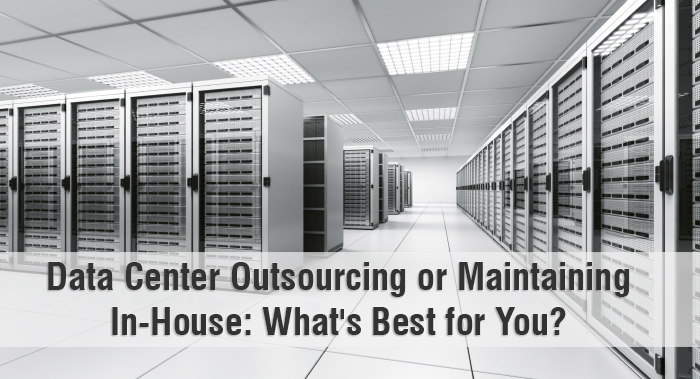
Data Center Outsourcing or Maintaining In-House: What’s Best for You?
This best-practices guide highlights the ten essential elements that distinguish an outsourced data center choice from an in-house development.
Data center outsourcing services is a burgeoning trend, with many large organizations welcoming the economic and operational perks associated with commercial colocation solutions.
There are millions of square feet of usable data center space, providing Fortune companies with a diversity of gains.
1. Uptime
Outsourced data center partners are required to provide service level agreements related to all the critical environmental and infrastructure components of the building. When an SLA is failed, the partner is obligated to offset the tenant. Consequently, the construction design and systems are generally state-of-the-art and managed at the highest level to avoid downtime and following monetary fines.
There’s a standard tier grading system to rate the resiliency of data centers. Below are the requirements for the system:
- Tier1: Basic site infrastructure with likely availability of 99.671%
- Tier 2: Redundant site infrastructure capacity components with likely availability of 99.741%
- Tier 3: Concurrently maintainable site infrastructure with likely availability of 99.982%
- Tier 4: Fault-tolerant site infrastructure with power storage and distribution facilities with likely availability of 99.995%
2. Risk Alleviation
Keeping distance between a business’s corporate headquarters and its production data center drops the risk of a particular event—such as a utility blackout or a natural calamity—taking out both facilities. Keeping a 25- to 500-mile distance between the headquarters and the data center is fitting, as this provides the team reasonable access to the data center, as well as a buffer of distance from the central hub.
The distance between facilities must take into consideration the latency threshold of the applications that are working in both locations. Today, many organizations are alleviating that risk by setting up data center hubs and colocation facilities in chief markets where outsourced data center partners offer high-quality inventory.
3. Speed of Delivery

Establishing a new data center or renewing an existing one can take up to two years. Today’s data center outsourcing partners in Dubai and in Abu Dhabi provide an accessible inventory of space and power, extending the flexibility for expansion and a scalable growth platform that can decrease the time to ownership by two to four months.
4. Reduced Power Charges
Power is one of the massive cost factors in a data center. Large-scale data centers typically use 100 to 200 watts per square foot of space, which allows them to negotiate very desirable rates with public utilities. In a data center hub market, power can cost 40 to 60 percent less than the societal average.
5. Operational Cost vs. Capital Cost
Lessening IT costs is one of the leading objects CIOs are asked to achieve every year. On average, it takes about 15 million dollars to construct a 10,000-square-foot, 1-megawatt data center. Excluding the charge of power, the operating and capital expenses to run and manage the data centers can take another 10 million to 15 million dollars in over ten years period. An outsourced data center partner will employ the entire infrastructure operating and capital expenses—economies that can be applied to IT gear and talent.
6. Connectivity
Connectivity and latency are two fundamental elements of any data center strategy. Most top-tier service providers enable multiple carriers to implement service into their buildings. This variety offers a tenant great leverage in contracting its telecom spending by unlocking up a variety of carrier tariff choices with least provisioning timeframes.
6. Focus
CIOs with in-house data centers have to engage key IT team members to contribute a significant amount of time administering their data centers. These exercises siphon away time that could be used enabling IT to promote strategies for high-powered rack densities, virtualization, and ever-changing data storage calls. In an outsourced data center model, the partner owns the burden of enhancing the infrastructure and building systems, which facilitates the CIO and IT team to focus on their crucial goals and best activities to bolster the business.
7. Regulatory Compliance/Audits
In today’s business milieu, more and more data falls under government or industry security and retention statutes. Maintaining these compliance measures is challenging without dedicated staff and resources. The outsourced data center model comes with compliance and audit capacities to adhere to different laws that question corporate data.
8. Ecosystem
The mixed-tenancy data center model renders an ambiance that is abundant from an ecosystem viewpoint. Along with a wide assortment of telephony options, tenants profit from the ability to cross-connect in the same building with other businesses that may be a share of their supply chain, customer base or financial dealing functionality. This ecosystem advantage improves latency-sensitive synergies.
Due to the novel requirements of data center facilities and the increasing need for data center infrastructure management, the decision of the outsourced data center site is vital to maintain uptime, alleviate risk, and achieve most availability and operating competence.
No related posts found
GLOBAL & REGIONAL BRANDS THAT TRUST IBT



























